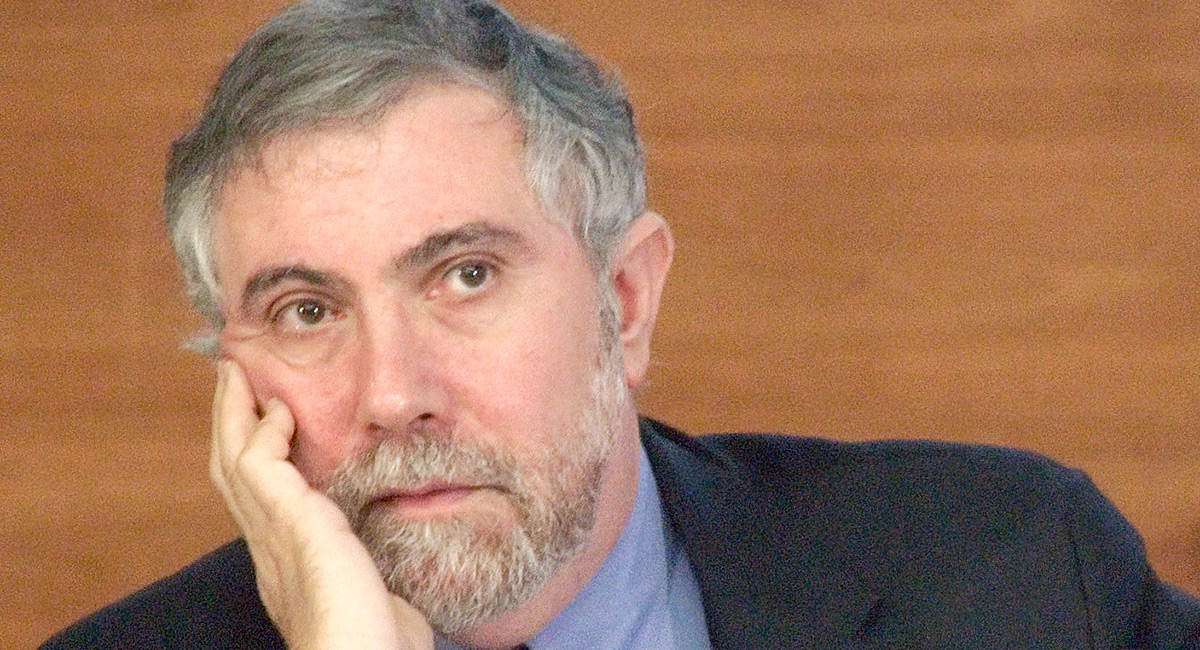In a recent column for the New York Times, the world’s most famous Keynesian Paul Krugman attacked Austrian business cycle theory (ABCT). In addition to repeating his decades-old claim that ABCT suffers from an internal contradiction, as well as his charge that the Austrians had misdiagnosed the 2008 financial crisis, in his latest piece Krugman argued that the 2020 pandemic really was a “reallocation shock” along Austrian lines. Yet even here, Krugman claims, the Austrian prescription of laissez-faire is dead wrong: as a new paper presented at the Jackson Hole monetary conference allegedly demonstrates, we need easy money from the Fed in order to rearrange labor without causing needless unemployment.
It won’t surprise Mises.org readers to learn that I disagree strongly with Krugman’s column. He makes some casual remarks that mislead his readers on the history of the 1930s, but more seriously, he misunderstands what ABCT actually says. This confusion leads him to reject the Austrian view as illogical, when in fact it is perfectly consistent and explains the data better than a Keynesian approach.
Krugman’s Faulty History
Krugman begins his discussion of the Austrian theory by reference to its place in the 1930s:
[T]he idea that there was a titanic intellectual battle in the 1930s between Hayek and John Maynard Keynes is basically fan fiction; Hayek’s views on the Great Depression didn’t get much intellectual traction at the time, and his fame came later, with the publication of his 1944 political tract “The Road to Serfdom.”
Already Krugman is making stuff up. (As I’ve written elsewhere, when Krugman uses the caveat “basically,” what he means is, “This statement is literally false.”) Although the clash may not have involved dueling rap lyrics, Hayek really was the chief rival of Keynes in the early 1930s. As Bruce Caldwellexplains:
In 1929 [Lionel] Robbins had begun what was to become his long tenure as head of the Economics Department at the London School of Economics (LSE). Robbins invited Hayek to London in January 1931, and the next month the young Austrian delivered a series of lectures on the business cycle. The lectures were published later that year (with an effusive foreword by Robbins) under the title, Prices and Production. Hayek’s lectures, though at times opaque, caused quite a stir. By the fall of 1931, Hayek had been appointed the Tooke Professor of Economic Science and Statistics at the University of London. He was thirty-two years old.
Sir John Hicks was at the LSE from 1926 to 1935 and remembers well the impact of Hayek’s arrival. Indeed, he divides his own stay at the University of London into a pre-Hayekian and a Hayekian period...In his article, ‘The Hayek story,’ Hicks reflects on the importance of Hayek’s early work.
“When the definitive history of economic analysis during the nineteen-thirties comes to be written, a leading character in the drama (it was quite a drama) will be Professor Hayek. Hayek’s economic writings—I am not concerned with his later work in political theory and sociology—are almost unknown to the modern student; it is hardly remembered that there was a time when the new theories of Hayek were the principle rivals of the new theories of Keynes. Which was right, Keynes or Hayek?”
Ludwig Lachmann writes of Hayek’s “triumphal entry on the London stage with his lectures on Prices and Production,” and recalls that when he (Lachmann) arrived at the LSE two years later, “all important economists there were Hayekians” ...
It’s undeniably true that in the eyes of the profession, Hayek lost the debate to Keynes. But Krugman is wrong to claim that Hayek was a minor player who was only known for his political writings.
Krugman Oversimplifies Austrian Business Cycle Theory
After downplaying its importance at the time, Krugman admits that there was an Austrian analysis of the Great Depression, and summarizes it in this way:
Nonetheless, there was an identifiable Austrian analysis of the Depression, shared by Hayek and other economists, including Joseph Schumpeter. Where Keynes argued that the Depression was caused by a general shortfall in demand, Hayek and Schumpeter argued that we were looking at the inevitable difficulties of adjusting to the aftermath of a boom. In their view, excessive optimism had led to the allocation of too much labor and other resources to the production of investment goods, and a depression was just the economy’s way of getting those resources back where they belonged. [Krugman 2021, bold added.]
In the above excerpt, Krugman makes a subtle but important misstatement of the Austrian explanation of the boom-bust cycle. Specifically, Krugman is casting ABCT as a theory of overinvestment in capital goods and underinvestment in consumer goods.[1]
Yet in reality, the sophisticated version of ABCT—especially in the writings of Mises—is more properly described as one of malinvestment among various types of capital goods coupled with too much consumption.
It is this simple confusion that drives most of the erroneous objections to ABCT coming from professional economists. In a 2012 journal article, Joe Salerno quotes extensively from such economists (including Krugman) and then clarifies:
Had the critics seriously studied the original sources in which ABCT is expounded, they would have learned that it is not an “overinvestment” theory at all. In fact, Mises, Rothbard and, somewhat less emphatically, Hayek argued explicitly that “overconsumption” and “malinvestment” were the essential features of the inflationary boom. In their view, the divergence between the loan and natural rates of interest caused by bank credit expansion systematically falsifies the monetary calculations of entrepreneurs choosing among investment projects of different durations and in different stages varying in temporal remoteness from consumers. But it also distorts the income and wealth calculations and therefore the consumption/saving choices of the recipients of wages, rents, profits and capital gains. In other words, while the artificially reduced loan rate encourages business firms to overestimate the present and future availability of investible resources and to malinvest in lengthening the structure of production, at the same time it misleads households into a falsely optimistic appraisal of their real income and net worth that stimulates consumption and depresses saving. [Salerno 2012, bold added.]
In the remainder of the current article, I’ll continue to quote from Krugman’s recent column and then show why his initial confusion about ABCT drives all of his problems with it. But to repeat: Krugman (and other ABCT critics) views ABCT as a simple theory of overinvestment in capital goods and underinvestment in consumption goods. But in reality, the Misesian theory is that credit expansion leads to artificially low interest rates, which in turn cause entrepreneurs to invest in the wrong lines and cause consumers to believe they are wealthier than they really are, and hence consume too much. Let us see how this confusion leads Krugman astray.
Krugman Alleges Problems With ABCT, Both Theoretical and Empirical
Returning to his recent column, below we reproduce two of Krugman’s long-running objections to ABCT, namely that it fails on both a theoretical and empirical level:
[The Hayek/Schumpeter] view had logical problems: If transferring resources out of investment goods causes mass unemployment, why didn’t the same thing happen when resources were being transferred in and away from other industries? It was also clearly at odds with experience: During the Depression and, for that matter after the 2008 crisis, there was excess capacity and unemployment in just about every industry—not slack in some and shortages in others.
In the quote above, Krugman’s “logical problem” with ABCT derives entirely from his superficial understanding of the theory. Yes, if Mises had actually argued that the boom period were merely a switch of preferences one way, while the bust were a switch back—sort of like consumers deciding to try Mountain Dew for a few years, only to revert back to Coke—then it would be weird to associate the first change with prosperity while the latter with privation.
This is why Salerno emphasized the overconsumption during the boom period, when individuals falsely believe they are richer than they really are. The boom is unsustainable in physical terms; the members of society are not saving enough out of total income in order to complete all of the long-term production processes initiated during the boom. Armed with cheap credit, the entrepreneurs use the injections of new money to bid workers away from their original jobs and into new lines. This necessarily involves higher (real) wages and thus induces a feeling of good times.
But when reality reasserts itself—typically when banks chicken out and stop injecting new credit into the system—many entrepreneurs realize their projects must be terminated. They lay off workers and halt their purchases of other inputs. Wages and other prices must fall (at least in real terms) to reflect the new reality. It is painful to be laid off; workers are poorer than they thought, and must search for a new job that doesn’t pay as well as their employer during the boom time.
For a systematic exposition of the Austrian narrative, showing how it is logically consistent and can explain the asymmetry between the boom and bust, see my 2008 “sushi article” here at Mises.org (which many readers have told me is one of their all-time favorites, for what that’s worth). In fact, Krugman himself praised my article at the time, and retreated from saying the ABCT had logical problems to merely alleging that it didn’t fit the data.
Space constraints prevent me from rehashing the arguments here, but on the issue of empirical validity, once again the Austrians triumph over the Keynesians. In this article, I summarized some of the “tests” Krugman had thrown against an Austrian-type explanation of the housing bubble and 2008 crisis. As it turned out, using Krugman’s own rules for the test, the Austrian explanation made more sense. (For example, percentage declines in employment were larger in construction than in manufacturing, and higher in durable goods than nondurable goods, and unemployment was highest in the states that had the biggest swings in home prices. These outcomes are to be expected in a “sectoral readjustment” Austrian story, as opposed to an “everybody panicked and stopped spending” Keynesian story.)
Hilarious: Krugman Resolves the “Logical Problem” When It Justifies Inflation
Before closing the present article, I want to highlight a hilarious aspect of Krugman’s latest commentary. The specific news hook for his discussion of ABCT was a formal paper presented by elite economists at the Federal Reserve’s Jackson Hole conference, held in August. Here is Krugman’s summary of the paper and its relevance to the Austrians:
Although we aren’t hearing much about Austrian economics these days, the pandemic really did produce an Austrian-style reallocation shock, with demand for some things surging while demand for other things slumped...
So we’re finally having the kind of economic crisis that people like Hayek and Schumpeter wrongly believed we were having in the 1930s. Does this mean that we should follow the policy advice they gave back then?
No.
That’s the message of a paper by Veronica Guerrieri, Guido Lorenzoni, Ludwig Straub and Iván Werning that was prepared for this year’s Jackson Hole meeting...Guerrieri et al. never explicitly mention the Austrians, but their paper can nonetheless be construed as a refutation of their policy prescriptions.
Hayek and Schumpeter were adamantly against any attempt to fight the Great Depression with monetary and fiscal stimulus. Hayek decried the use of “artificial stimulants,” insisting that we should instead “leave it to time to effect a permanent cure by the slow process of adapting the structure of production.”...
But these conclusions didn’t follow even if you accepted their incorrect analysis of what the Depression was all about. Why should the need to move workers out of a sector lead to unemployment? Why shouldn’t it simply lead to lower wages?
The answer in practice is downward nominal wage rigidity: Employers are really reluctant to cut wages, because of the effects on worker morale....
Guerrieri et al. argue, with a formal model to back them up, that the optimal response to a reallocation shock is indeed a very expansionary monetary policy that causes a temporary spike in inflation. Workers would still have an incentive to change jobs, because real wages would fall in their old jobs but rise elsewhere. But there wouldn’t have to be large-scale unemployment....
... Now that we’ve finally had the shock Austrian economists kept imagining, we can see that they were still giving very bad advice.
And in case you’re wondering, the Fed, by accepting transitory inflation, is getting it right. (Krugman 2021, bold added)
To summarize: The new paper by Guerrieri et al. argues that if accommodated by a burst of inflation, we can transfer workers from one sector to another without the need for large-scale unemployment. However, if the Fed doesn’t inflate, then the need to reallocate workers will lead to large-scale unemployment.
Does the reader see the irony? That asymmetry has been Krugman’s chief objection (“logical problem”) to ABCT for decades. No matter how many times Austrians explained it to him, he just couldn’t wrap his head around the notion that monetary inflation might move workers around without causing an initial surge in unemployment.
Yet when that same exact mechanism is invoked in order to justify the inflation—rather than to condemn it, as the Austrians do—then all of a sudden Krugman is able to understand the process. Incentives really do matter.
Note
[1] Another problem is that Krugman says Hayek thought the overinvestment of the boom period is due to “excessive optimism,” when in fact Hayek blamed the investment mistakes on the distortion of interest rates caused by credit expansion. Indeed, that’s why Hayek’s book on ABCT is called Prices and Production, not Optimism and Production. (Thanks to Joe Salerno for pointing this out when reading an initial draft of the present article.)










